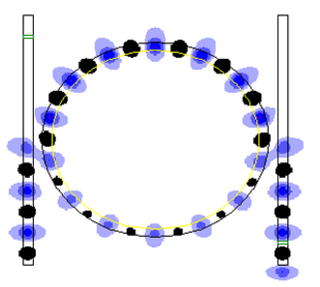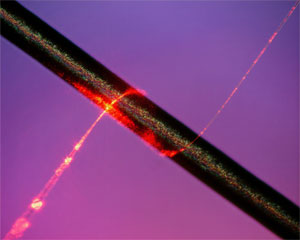
An optical ring resonator is a set of waveguides in which at least one is a closed loop coupled to some sort of light input and output. The concepts behind optical ring resonators are the same as those behind whispering galleries except that they use light and obey the properties behind constructive interference and total internal reflection. When light of the resonant wavelength is passed through the loop from the input waveguide, the light builds up in intensity over multiple round-trips owing to constructive interference and is output to the output bus waveguide which serves as a detector waveguide. Because only a select few wavelengths will be at resonance within the loop, the optical ring resonator functions as a filter. Additionally, as implied earlier, two or more ring waveguides can be coupled to each other to form an add/drop optical filter.

An optical microcavity or microresonator is a structure formed by reflecting faces on the two sides of a spacer layer or optical medium, or by wrapping a waveguide in a circular fashion to form a ring. The former type is a standing wave cavity, and the latter is a traveling wave cavity. The name microcavity stems from the fact that it is often only a few micrometers thick, the spacer layer sometimes even in the nanometer range. As with common lasers, this forms an optical cavity or optical resonator, allowing a standing wave to form inside the spacer layer or a traveling wave that goes around in the ring.
Nanophotonics or nano-optics is the study of the behavior of light on the nanometer scale, and of the interaction of nanometer-scale objects with light. It is a branch of optics, optical engineering, electrical engineering, and nanotechnology. It often involves dielectric structures such as nanoantennas, or metallic components, which can transport and focus light via surface plasmon polaritons.

Silicon photonics is the study and application of photonic systems which use silicon as an optical medium. The silicon is usually patterned with sub-micrometre precision, into microphotonic components. These operate in the infrared, most commonly at the 1.55 micrometre wavelength used by most fiber optic telecommunication systems. The silicon typically lies on top of a layer of silica in what is known as silicon on insulator (SOI).

William James Dally is an American computer scientist and educator. He is the chief scientist and senior vice president at Nvidia and was previously a professor of Electrical Engineering and Computer Science at Stanford University and MIT. Since 2021, he has been a member of the President's Council of Advisors on Science and Technology (PCAST).

A slot-waveguide is an optical waveguide that guides strongly confined light in a subwavelength-scale low refractive index region by total internal reflection.

A subwavelength-diameter optical fibre is an optical fibre whose diameter is less than the wavelength of the light being propagated through it. An SDF usually consists of long thick parts at both ends, transition regions (tapers) where the fibre diameter gradually decreases down to the subwavelength value, and a subwavelength-diameter waist, which is the main acting part. Due to such a strong geometrical confinement, the guided electromagnetic field in an SDF is restricted to a single mode called fundamental.
Silicon Photonics Link is a silicon-based optical data connection developed by Intel Corporation which uses silicon photonics and hybrid silicon laser, it provides 50 Gbit/s bandwidth. Intel expected the technology to be in products by 2015.
Optofluidics is a research and technology area that combines the advantages of fluidics and optics. Applications of the technology include displays, biosensors, lab-on-chip devices, lenses, and molecular imaging tools and energy.

A hybrid plasmonic waveguide is an optical waveguide that achieves strong light confinement by coupling the light guided by a dielectric waveguide and a plasmonic waveguide. It is formed by separating a medium of high refractive index from a metal surface by a small gap.

Plasmonics or nanoplasmonics refers to the generation, detection, and manipulation of signals at optical frequencies along metal-dielectric interfaces in the nanometer scale. Inspired by photonics, plasmonics follows the trend of miniaturizing optical devices, and finds applications in sensing, microscopy, optical communications, and bio-photonics.

Luigi Lugiato is an Italian physicist and professor emeritus at University of Insubria (Varese/Como). He is best known for his work in theoretical nonlinear and quantum optics, and especially for the Lugiato–Lefever equation (LLE,). He has authored more than 340 scientific articles, and the textbook Nonlinear Dynamical Systems. His work has been theoretical but has stimulated a large number of important experiments in the world. It is also characterized by the fact of combining the classical and quantum aspects of optical systems.
Integrated quantum photonics, uses photonic integrated circuits to control photonic quantum states for applications in quantum technologies. As such, integrated quantum photonics provides a promising approach to the miniaturisation and scaling up of optical quantum circuits. The major application of integrated quantum photonics is Quantum technology:, for example quantum computing, quantum communication, quantum simulation, quantum walks and quantum metrology.
Kerr frequency combs are optical frequency combs which are generated from a continuous wave pump laser by the Kerr nonlinearity. This coherent conversion of the pump laser to a frequency comb takes place inside an optical resonator which is typically of micrometer to millimeter in size and is therefore termed a microresonator. The coherent generation of the frequency comb from a continuous wave laser with the optical nonlinearity as a gain sets Kerr frequency combs apart from today's most common optical frequency combs. These frequency combs are generated by mode-locked lasers where the dominating gain stems from a conventional laser gain medium, which is pumped incoherently. Because Kerr frequency combs only rely on the nonlinear properties of the medium inside the microresonator and do not require a broadband laser gain medium, broad Kerr frequency combs can in principle be generated around any pump frequency.

Keren Bergman is an American electrical engineer who is the Charles Batchelor Professor at Columbia University. She also serves as the director of the Lightwave Research Laboratory, a silicon photonics research group at Columbia University. Her research focuses on nano-photonics and particularly optical interconnects for low power, high bandwidth computing applications.
Andrew Marc Weiner OSA NAE NAI was an American electrical engineer, educator and researcher known for contributions to the fields of ultrafast optics and optical signal processing. He was the Scifres Family Distinguished Professor of Electrical and Computer Engineering at Purdue University.
Joyce Poon is Professor of Electrical and Computer Engineering at the University of Toronto and Director of the Max Planck Institute of Microstructure Physics, where her research focuses on developing new optical devices for applications in neurotechnology. She is also an honorary professor at the Technical University of Berlin. She is a Fellow of Optica, and has been serving as a Director-At-Large for the society since January 2021.
Amy Carole Foster is an American engineer who is an associate professor in the Department of Electrical and Computer Engineering at Johns Hopkins University. Her work considers nonlinear optics and silicon-based photonic devices.
Alexander Luis Gaeta is an American physicist and the David M. Rickey Professor of Applied Physics at Columbia University. He is known for his work on quantum and nonlinear photonics. He is a Fellow of the American Physical Society, Optica, and of the Institute of Electrical and Electronics Engineers.
Sasikanth Manipatruni is an American engineer and inventor in the fields of Computer engineering, Integrated circuit technology, Materials Engineering and semiconductor device fabrication. Manipatruni contributed to developments in silicon photonics, spintronics and quantum materials.








